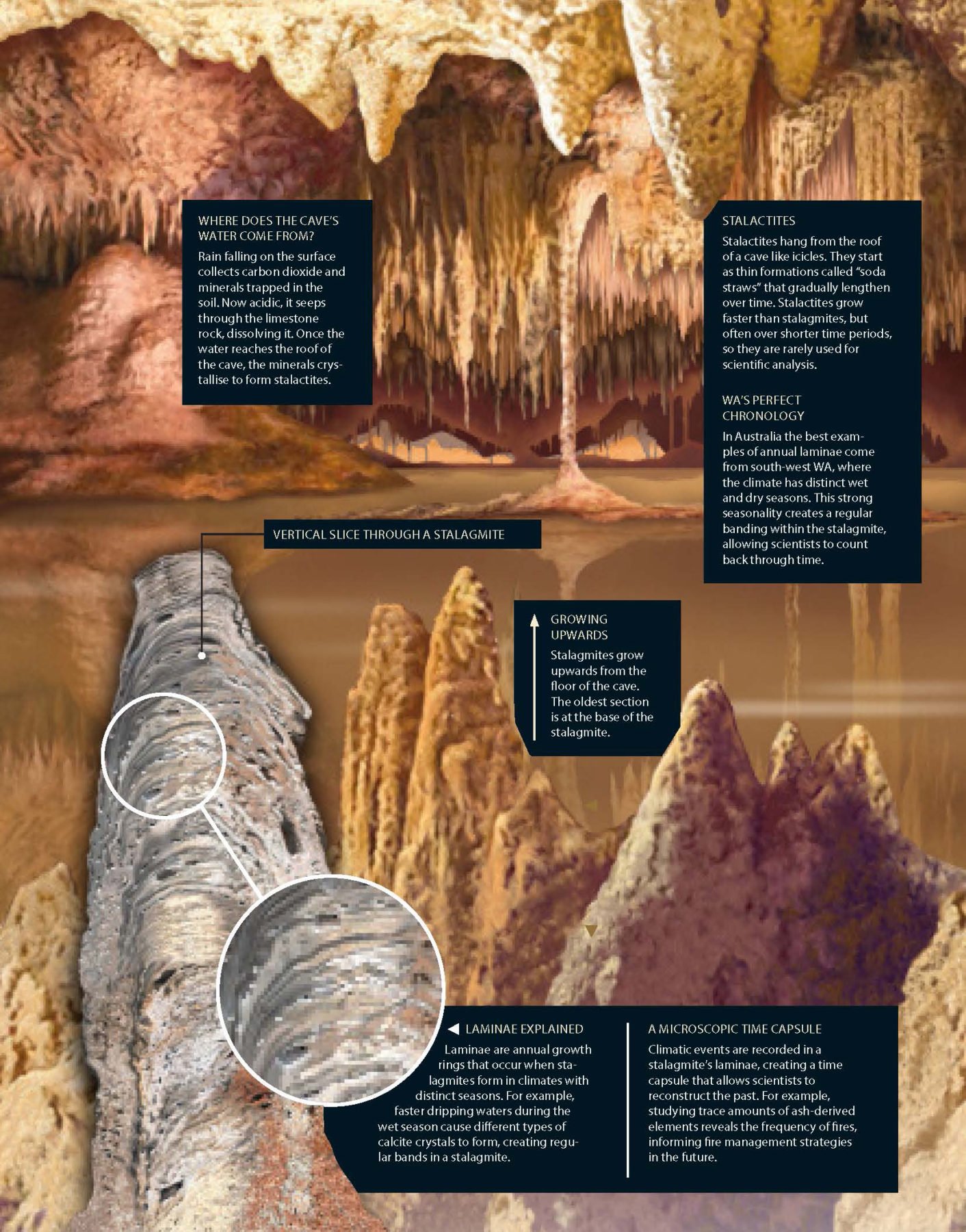Microscopic layers of stalagmites provide clues to earlier climate changes

THE TAPERING AND sometimes towering mineral deposits called stalagmites, which rise from cave floors, have an internal structure that, like the rings of tree trunks, can retain climate signals in a precise chronology.
Now an Australian-based study has revealed that stalagmite growth is more consistent than previously thought, increasing its value as a record of past events. “Our new global analysis shows we can consider stalagmite growth as being like a metronome and very constant over hundreds and thousands of years,” says Professor Andy Baker, a world-renowned stalagmite researcher at Sydney’s University of New South Wales.
Analysing samples from 23 caves across six continents, Andy and his team discovered that stalagmites grow about 100 micrometres a year – one-tenth of a millimetre. It takes a stalagmite 10 years to grow 1mm and 100 years to grow 1cm. “Sometimes extreme weather events can disturb this metronome for a few years, making the growth a bit faster or slower,” Andy explains. “But in general, stalagmite growth is predictable and it is this unique property that makes them so valuable to researchers.”
Stalagmites and stalactites are formed by water droplets seeping into a cave from the world above. As a raindrop trickles through the ground, it collects carbon dioxide and minerals from decaying matter trapped in soil layers. This turns the water acidic and capable of dissolving limestone. When the droplet reaches the roof of a cave, some of this dissolved limestone is precipitated, leaving behind a microscopic ring of calcite crystals. The deposit slowly accumulates, to create a formation that is thin and hollow, like a drinking straw. Eventually, the straw will become blocked with calcite or other impurities, thickening in size as water runs down its outer surface and transforming into a stalactite.
As the ceiling drips fall to the floor, calcite is deposited, which leaves solid rock behind. These are the stalagmites that rise up from the floor of a cave. In a process that can take up to 100,000 years, stalagmites and stalactites will eventually join from floor to ceiling, forming a pillar. This slow rate of growth means collecting stalagmite samples can raise conservation issues. And so researchers will instead use stalagmite samples that are already broken, or drill down from the structure’s top to discreetly remove its core.

In regions with seasonal precipitation – distinct wet and dry seasons – stalagmites accumulate annual growth rings called “laminae”. It’s these features that leave a small but distinct change in the chemistry of a stalagmite, providing scientists with a highly accurate sequence of past climate events.
“They are like clocks that keep ticking every year; they accumulate a layer so we can count back through time,” Andy says. “A wet season may allow more dissolved or fine particulate material to be transported from the soil, which sometimes changes the type of calcite crystals in the stalagmite. This is followed by a drier season, with slower dripping and less soil-derived material. Over the course of the year, these two features alternate.”
The best place to find these annually laminated stalagmites in Australia, according to Andy, is in south-west Western Australia, particularly in the Margaret River region and further north towards Perth. “That’s the only part of Australia with a Mediterranean climate and a strong seasonality,” he says. “It’s cold and wet in winter and warm and dry in summer, so the stalagmites there have this nice, regular banding.”
Extreme weather occasionally disrupts this perfect chronology, allowing scientists to explore climate variations. The El Niño Southern Oscillation (ENSO) and the North Atlantic Oscillation typically last 5–10 years, creating irregularities within stalagmite laminae. Caves in eastern Australia are affected by ENSO.
“During an El Niño drought period, the water store above a cave will drain and the growth of stalagmites will slow down. In La Niña it will be wet, so the stalagmites will grow faster,” Andy says.
In a project led with Dr Pauline Treble (ANSTO), they have been able to reconstruct WA’s fire histories from traces of dissolved ash discovered within stalagmite layers. This record occurs when ash deposits from burnt vegetation dissolve and wash down into the subsurface layer of the cave. “Some of this soluble ash contains the nutrients and micronutrients that were previously in the plants,” Andy says. “It gets transported to the stalagmites and gets trapped within these annual layers. When we count back through time and see these concentrations of nutrients and micronutrients, we can identify when a fire occurred in the past.”
Stalagmite records from Yanchep National Park, north of Perth, reveal regular fire events dating back 300 years. By comparing these stalagmite records with known fires, hazard reduction, burnt histories and satellite data, scientists can uncover the past and better understand fire management in pre-European times.



